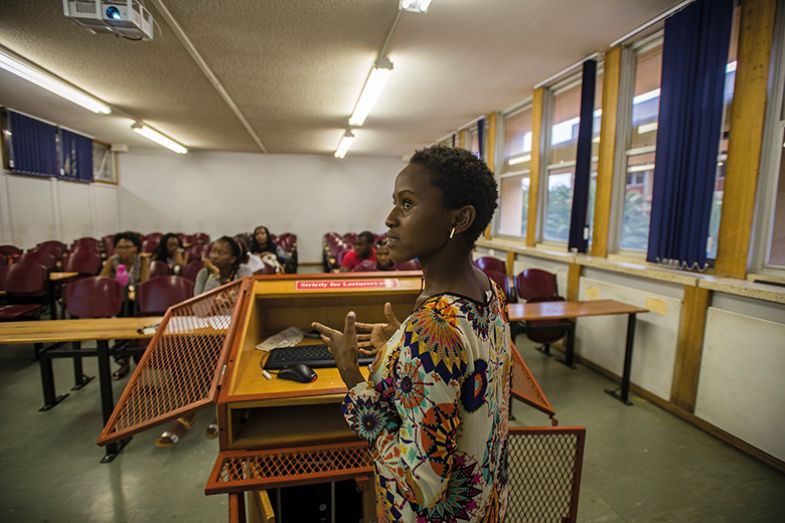World University Rankings 2023: results announced
Browse the full results of the World University Rankings 2023
Download a copy of the World University Rankings 2023 report
To describe the past three years in higher education as tumultuous would be something of an understatement. The pandemic and its lingering impact on borders, plus a war in Europe and rising anti-science rhetoric have collided to make the early 2020s some of the most difficult years for universities in recent history.
This year the data used in the World University Rankings are beginning to reflect the chaos caused by the pandemic: what they show is that many systems entered this period of disruption in positions of strength.
Here, we look at some of the top trends to emerge from this year’s rankings, and what they might mean for the future.
North American slump and Oceania rising
North America, in particular the US, has for a long time reigned supreme over higher education. At the highest level, US institutions continue to dominate, with 12 universities in the top 20, but taking a broader view of US performance, it is clear that the crown is slipping. This year, for the first time, continental data reveal that Oceania has overtaken North America to enjoy the distinction of the highest average overall score (based on universities ranked each year since 2018).
The average score across Oceania is 51.4, compared with 50.4 in North America; last year, both regions scored 50.4.
Having increased by 6.4 points over the past six years, the overall score of Australia has now almost equalled the overall score of the United States.
So, what is behind the North American stagnation? The data reveal a steady drop in scores for citations over the past two years: currently the continent’s average score for citations is 68.8, compared with 70.1 in 2018. North America’s average score for research reputation has dropped since 2018 from 25.5 to 24.0, and for teaching reputation from 25.9 to 23.6, based on universities that were ranked every year from 2018 to 2023.
Simon Marginson, director of the Centre for Global Higher Education at the University of Oxford, says the expanding number of world-class universities is having “a slight crowd-out effect in relation to US universities”, causing a small relative decline in reputation. THE’s reputation survey asks the world’s top scholars to name the 15 best institutions for teaching and research; the finite number means this is a story of a growing number of excellent universities outside the US, rather than American universities declining in quality.
“There’s no evidence that US research is weakening in an absolute sense, or US universities are in any way in decline,” Marginson says. “This continues to be the most prestigious system in the world.”
Oceania, on the other hand, has been enjoying a steady rise in average score for every pillar in the rankings since 2018. In particular, the continent is excelling in citations and international working.
This increase is largely driven by Australian institutions: the average overall score for Australian universities ranked each year is currently 52.9, up from 51.7 last year and 46.5 in 2018.
Andrew Norton, professor of higher education at the Australian National University, attributes the rise in part to a boost in funding for research over the past 15 years.
Merlin Crossley, deputy vice-chancellor at the University of New South Wales, says the Australian government’s Excellence in Research for Australia (ERA) strategy, initiated in 2010, certainly helped. “But other things helped too. Australia built up some superb research fellowship programmes, in medical research first, then, with the Australian Research Council’s Future Fellowships, across the board. This warded off the well-meaning hand of nepotism and supported top people to do good work.”
The rise in both citations and international working is no coincidence, according to Gavin Moodie, professor of higher education at the University of Toronto, who has much experience of the Australian system. “Several years ago the Australian government’s performance-based research funding rewarded volume of publications. However, a series of studies demonstrated that this was at the expense of research quality for which citations were a better measure. Soon thereafter, a few studies showed that citations were higher for publications with authors from more than one country, so university researchers started seeking to increase citations and thus international collaborations. This move was reinforced by ERA, which adopted similar indicators of research quality.”

The data on international students and staff reflect the academic year 2019-20, therefore the full force of Australia’s strict border control in reaction to the pandemic is yet to be felt. Could the hard border reverse the growing international presence of Australian universities?
Norton believes the decline in international students will have an impact because the cash they bring in is used to fund research. Furthermore, “the number of research academics has fallen, and during 2020 especially the loss of casual staff meant that ‘teaching and research’ academics needed to spend more time on teaching than usual. However, the lagging nature of publications and citations means that it may take a few years for this to show clearly in the citation numbers.”
“Some Australian universities have been successful in getting students to study online, but generally the fees and therefore profits are lower,” he adds.
Crossley is optimistic: “Online collaboration helped me during the pandemic. Colleagues I usually saw once every two years, I called on Zoom regularly. Many of our labs stayed open across the pandemic. We’re back travelling again now. We have deep links to the UK and Europe, America, and Asia. The world’s population centre of gravity is in Asia and we’re in that time zone. I’m hoping we’ll keep evolving as either a sort of Scandinavia or perhaps a Canada of the south.”

A weak link in China
The rise of Chinese universities has been the big global higher education story of the decade, but the latest data may reveal a weak link.
While the country’s overall score is still rising, metrics reflecting internationalism are stagnating or declining.
China’s average score for international outlook dropped from 34.1 last year to 32.6, based on all Chinese universities ranked in 2022 and 2023; the country’s average score for international students has dropped from 33.9 to 32.4, international co-authorship from 24.0 to 22.5, and international staff from 44.3 to 43.0.
As these data reflect the academic year 2019-20, the pandemic border closure is not the driving factor behind the decline.
Geopolitical tensions are more likely the culprit.
As the education system has improved there may be fewer incentives for Chinese universities to forge external links, but Western governments have certainly become increasingly jittery about links with Chinese academia.
Under former US president Donald Trump, the US Justice Department took a more punitive approach to university links to China by investigating professors at US universities over whether they disclosed financial ties when seeking federal grant funding and scrutinising visiting Chinese scholars from military affiliated universities.
In the UK, GCHQ, the government’s communications headquarters, warned universities about “hostile state actors” targeting British institutions to steal personal data, research data and intellectual property that could be used for their own “military, commercial and authoritarian interests”.
Marginson posits that as Chinese scientists and doctoral students have become less welcome in some countries than they used to be, “it is likely that sooner or later, higher education in China will [be] less welcoming to outsiders from at least those countries. That is the logic of international relations.”
“It would be regrettable if the growth of foreigners working in higher education in China has stopped, as the engagement is good for everyone. However, it would be unsurprising, as we are now in a more conflictual era in the geopolitics of higher education,” Marginson added.
“It would be safe to say that geopolitics is playing a significant role,” says James Laurenceson, director of the Australia-China Relations Institute at the University of Technology Sydney. “It is certainly the case that Chinese academics are more cautious and have to jump through more bureaucratic hoops to engage [with their] foreign counterparts than five years ago. Some have judged that it’s best just to keep their heads down.”
Governments outside China are making engagement harder, Laurenceson says, giving the example of Australian Research Council discovery grants involving collaboration with China dropping to 23 this year, from 48 in 2021 and 79 in 2019.
He says the Australian government has made “extensive efforts” to “sensitise universities and academics to risks around foreign interference. On one level that’s a perfectly reasonable thing to do. But it is also leading to significant self-censorship by Australian academics not wanting to be tarnished with a foreign interference brush, even if their engagement is entirely defensible based on the facts.”
The wilting global collaboration metrics do not take away from China’s overall positive picture however, as the country’s average score has risen from 31 six years ago to almost 42 this year. This year, for the first time, there are 11 Chinese institutions in the top 200 and seven in the top 100.
Chinese universities are exceptionally good at securing funding from industry, with the average score for the industry pillar outperforming the world average by 13.1 points, and when it comes to research quality as measured by citations, China is steadily catching up with the US.

Others on the rise
And there are plenty more positive stories to be found in this year’s data. Not least the rise of Africa. There are 25 new African universities in the ranking and Zambia, Namibia, Mozambique, Zimbabwe and Mauritius are all represented for the first time. There are now 17 African countries in the ranking in total, compared with nine in 2018, reflecting the continued improvement in research and teaching on the continent.
Nigeria in particular is improving rapidly. There are now 12 Nigerian universities ranked, twice as many as last year. Since last year the country’s average overall score has risen from 27.9 to 31.5.
When comparing continents over the past six years, Africa has seen the largest increase in average score for citations since 2018, with a rise of 19.2 points.
Over in the Middle East, two countries that are improving their overall score at a faster rate than the global average are Saudi Arabia and United Arab Emirates (UAE).
Saudi Arabia has had the biggest increase in overall score since last year, with an average overall score of 50, compared with 45 last year; since 2018 the average score has risen by 17 points. The country scores particularly well on the international pillar, and on international staff especially.
UAE saw a similar rise, with an average overall score of 44.4, up from 40.0 last year.
Over the next couple of years the rankings data will paint a more detailed picture of the impact of the pandemic, but what we can see so far is that despite the many problems facing humanity, university systems across the world are resilient.
POSTSCRIPT:
Print headline: Shifting global picture
Register to continue
Why register?
- Registration is free and only takes a moment
- Once registered, you can read 3 articles a month
- Sign up for our newsletter
Subscribe
Or subscribe for unlimited access to:
- Unlimited access to news, views, insights & reviews
- Digital editions
- Digital access to THE’s university and college rankings analysis
Already registered or a current subscriber? Login





